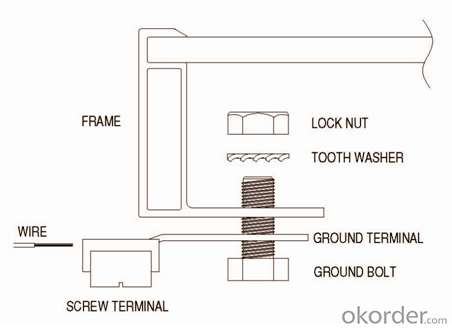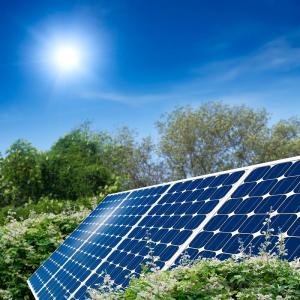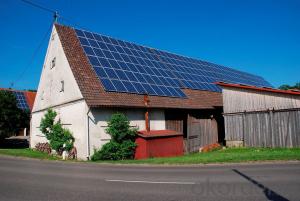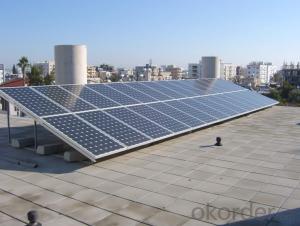Silicon Polycrystalline Solar Panel 240W
- Loading Port:
- Guangzhou
- Payment Terms:
- TT OR LC
- Min Order Qty:
- 200000 watt
- Supply Capability:
- 20000000 watt/month
OKorder Service Pledge
OKorder Financial Service
You Might Also Like
INTRODUCTION
This installation Manual contains essential information for the electrical and mechanical installation that your must know before installing CUSTOMER PV modules. This also contains safety information you need to be familiar with .All the information described in this manual are the intellectual property of CNBM and based on the technologies and experiences that have been acquired and accumulated in the long history of CUSTOMER. This document does not constitute a warranty, expressed or implied.
GENERAL INFORMATION
The installation of PV modules requires a great degree of skill and should only be performed by a qualified licensed professional, including licensed contractors and licensed electricians. Please be aware that there is a serious risk of various types of injury occurring during the installation including the risk of electric shock. All CUSTOMER modules are equipped with a permanently attached junction terminal box that will accept variety of wiring applications or with a special cable assembly for ease of installation, and they do not require assembly.
GROUDING
All PV models must be grounded by electrical connection of the module frames to ground. Please be careful in arranging the system ground so that the removal of one module from the circuit will not interrupt the grounding of any other modules.
The modules should be grounded to the same electrical point as described below.
Each PV module has a hole on the side frame of either a bolt, nut and washer grounding the module to the frame, a ground lug fastened by bolt or screw, or appropriate screw(hardware not provided).An example of acceptable ground connection using a bolt, nut and washer retaining a ground lug is shown in figure 3,in a connection of this type, the hardware(such as a toothed locked washer/star washer) must score the frame surface to make positive electrical contact with the frame. The ground wire must be considered within the requirement of local and regulation at the site of installation.

DATA SHEET
Maximum Power | 240W |
Efficiency | 0.148 |
Backsheet | White |
Frame Colar | Silver |
Manufacture Site | China |
Frame | Anodized Aluminum Alloy |
Weight | 19 kg |
- Q:where I can find solar panel the has 4.8 volts? Like those solar walkway light or something that has 4.8 volts solar panel.Do you think I can get it from home depot?
- How Solar Cells Work by Scott Aldous Inside This Article . Introduction to How Solar Cells Work 2. Photovoltaic Cells: Converting Photons to Electrons 3. How Silicon Makes a Solar Cell 4. Anatomy of a Solar Cell 5. Energy Loss in a Solar Cell 6. Solar-powering a House 7. Solving Solar-power Issues 8. Solar-power Pros and Cons 9. Lots More Information 0. See all Physical Science articles You've probably seen calculators that have solar cells -- calculators that never need batteries, and in some cases don't even have an off button. As long as you have enough light, they seem to work forever. You may have seen larger solar panels -- on emergency road signs or call boxes, on buoys, even in parking lots to power lights. Although these larger panels aren't as common as solar powered calculators, they're out there, and not that hard to spot if you know where to look. There are solar cell arrays on satellites, where they are used to power the electrical systems. You have probably also been hearing about the solar revolution for the last 20 years -- the idea that one day we will all use free electricity from the sun. This is a seductive promise: On a bright, sunny day, the sun shines approximately ,000 watts of energy per square meter of the planet's surface, and if we could collect all of that energy we could easily power our homes and offices for free.
- Q:Can solar panels be installed on a carport?
- Yes, solar panels can be installed on a carport. In fact, carports are an ideal location for solar panel installation as they provide ample space, unobstructed sunlight, and can also serve as a shade provider for parked cars.
- Q:hey so im doing this project for my technology class and i was wondering what different colours solar panels can be. also is it possible to have kentic power as a back up power if batteries dont work? thx in advance
- Panels can come in a selection of colors, and trimmed in a variety of frames. Most are dark, black, blue or reddish in hue. Concentrators may appear white from a distance. Kinetic back up is possible in the form of a flywheel. Not very common but it is out there. Another form of kinetic backup that is used by some power companies is hydro. When the sun is out and the system is producing more than is used, the excess can be used to pump water uphill to a holding tank. Then when there is a demand, the water is allowed to flow back down turning a turbine to generate electricity.
- Q:want to run 400 watt heater 8 hrs a day how many solar panels do i need and batteries
- You could do that, but it would be an expensive way to go. If what you really want is heat, consider heating water directly with conventional solar water heaters, and storing it in a large, insulated tank. You can then circulate the water through a conventional radiator at night.
- Q:Are there government incentives for installing solar panels?
- Yes, there are indeed government incentives available for installing solar panels. These incentives can vary depending on the country and region, but they often include tax credits, grants, rebates, and net metering programs. These incentives are designed to encourage the adoption of renewable energy sources like solar power, making it more affordable and attractive for individuals and businesses to invest in solar panel installations.
- Q:i used 734 killowatts of power last month, any idea on how many solar panels i would need. What im looking for is to somehow hook up my central air to solar panels.
- I had a system installed last year and am very happy with it so far. When I was getting quotes from companies we used a 3 year usage history that I was able to get from my utility. I live in an area that allows me to sell back my excess or let my meter run backwards, which really helps reduce costs. The amount of energy you use and can produce will vary during the year. I had monthly usage under 800 kwh and months over 2000 kwh. I have become more aware of my usage and have made adjustments to appliances and habits to cut my usage down. I installed a 3.74 kw dc system. On average in the summer I generate 35 kwh per day and in the winter I averagae around 2 kwh per day, but I've seen days as low as 2kwh. I don't see the benefit to hooking up a system to specifice appliances for 2 reasons. Your a/c doesn't run non stop, so the energy you produce when the system cycles off is lost. You only produce electricity when the sun is shining on the panels. If you have a cloudy day or it is hot after the sun goes down, you will need to still use household energy. My system doesn't zero out my bill, but it reduces it by about 75% in the summer and at least 50% in the winter. My bills were over $200 many months, my highest summer bill was $20 and highest winter bill was $35. My system cost $26K (less than my pool or hardwood floors), I got a $0K rebate from my utility and a $2K federal tax credit. The fed. tax credit has increased this year to 30% of the total installed price. I should break even in 6-7 years and save well over $50K over the life of the panels.
- Q:How much space is required for installing solar panels?
- The amount of space required for installing solar panels depends on various factors such as the type and size of the panels, the energy needs of the property, and the efficiency of the panels. Generally, for residential installations, it is recommended to have around 100-400 square feet of roof space per kilowatt of solar panels. However, ground-mounted systems may require larger areas depending on the number of panels and their tilt angles. It is advisable to consult with a solar installer or expert to determine the exact space requirements for a specific project.
- Q:i attached a usb charger to my solar panel(it has an output of about .2 volts) but i read on my multimeter its only using about 8 volts however on the conventional wall charger that i use to charge it has an output of about 5. volts.... i believe that my mp3 player is not charging it does not display the charging icon when it is on or off ....is this becuase the output is higher ? do i need to install a volt dropping diode to prevent it from putting to much energy at once? (my mp3 charges fine on the wall charger but does not seem to respond to the solar panel so it the circuits are fine....)
- You description is not clear as to what is supplying and what is consuming the .2, 8, and 5. volts you mention. I get that your solar panel output is .2 VDC (volts DC), but is that open circuit or under load? Also, is the charger output AC or DC? What's using 8 volts? Circuits don't selectively use a portion of the voltage supplied. They use all or nothing. Is the polarity correct from your solar panel to your MP3 player? If your MP3 player requires DC for charging and you're feeding it the correct polarity, but too high a voltage, an overvoltage protection circuit in your MP3 charging circuit might be blocking the charging current from your solar panel. Go through everything again and if you need to post another question on YA, be specific as to what you're measuring, where, and whether it's the source or load you're measuring.
- Q:I need a solar panel which can light up 4 full loaded 5 rooms appartment houses
- good idea going solar, i would suggest doing a google search, as their are many suppliers. then you need to calculate the amount of wattage you think these apartment houses are going to require. volts x amps = watts. if you are going to be off of the power grid, then you will need a way to store excess energy during good times,( lots of sun) in order to use it during bad times ( no sun ). or see if you are able to sell your extra power back to your local power company, check because some companies do not allow this. you could even have a generator for emergencies if you go off the power grid. on final note, solar is a pretty sizable investment up front and your profits are seen mainly in the long run, but you will get energy savings immediately, but more likely those savings will go to paying off the solar panels also, you will need a converter to convert the ac (alternate current) produced by the panels into dc ( direct current ) which is used by the apartments. it will tie in to the existing electrical system in the apartments. i know germany is really pushing solar energy and they offer their citizens some pretty sweet deals to go solar. the companies are profiting from this so i would suggest looking for a supplier in germany, first. they may have better deals, or try bp (british petroeum) they have been in the solar business for awhile. i wish you success!
- Q:Which is more efficient at producing energy? Reference(s) would be nice, but not required.
- Of course solar panels
1. Manufacturer Overview |
|
|---|---|
| Location | |
| Year Established | |
| Annual Output Value | |
| Main Markets | |
| Company Certifications | |
2. Manufacturer Certificates |
|
|---|---|
| a) Certification Name | |
| Range | |
| Reference | |
| Validity Period | |
3. Manufacturer Capability |
|
|---|---|
| a)Trade Capacity | |
| Nearest Port | |
| Export Percentage | |
| No.of Employees in Trade Department | |
| Language Spoken: | |
| b)Factory Information | |
| Factory Size: | |
| No. of Production Lines | |
| Contract Manufacturing | |
| Product Price Range | |
Send your message to us
Silicon Polycrystalline Solar Panel 240W
- Loading Port:
- Guangzhou
- Payment Terms:
- TT OR LC
- Min Order Qty:
- 200000 watt
- Supply Capability:
- 20000000 watt/month
OKorder Service Pledge
OKorder Financial Service
Similar products
New products
Hot products
Related keywords




























